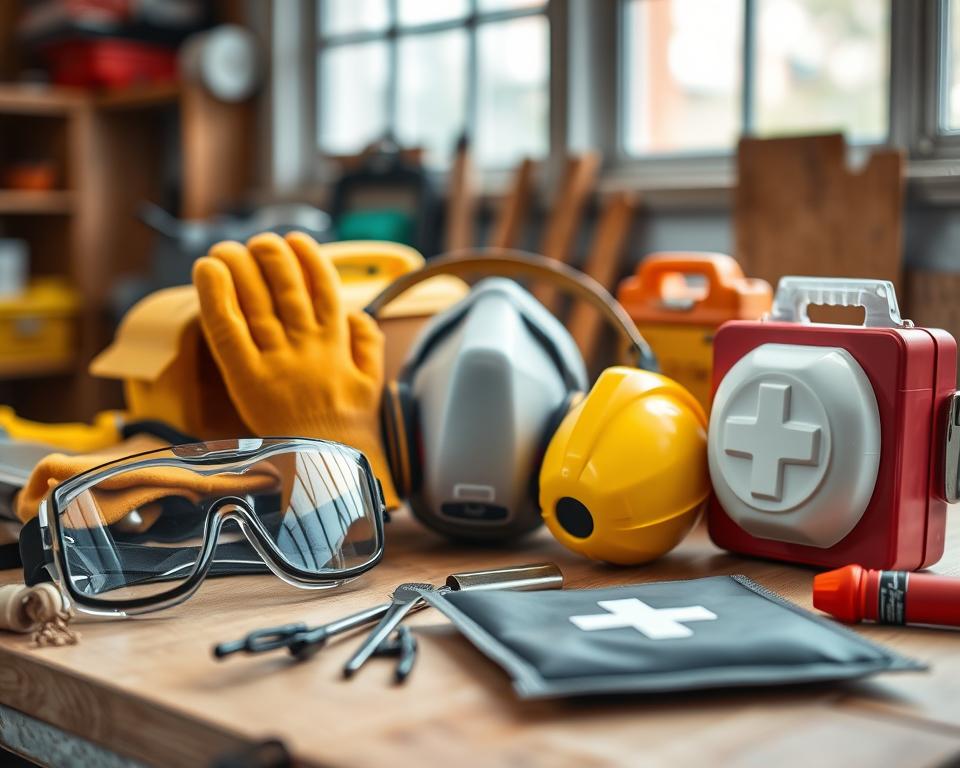Anúncios
Tools guide — are you buying what you need or just collecting gear that gathers dust?
You want a practical list that covers real home projects without waste. This short buyer’s intro shows where newcomers and seasoned people most often slip up, and how simple checks stop costly errors.
We use clear examples like a compact DeWalt 20V drill, a Stanley claw hammer, and an Anker flashlight to compare basic picks. Safety is front and center: eye protection, metal storage for flammables, and battery handling are all nonnegotiable.
By the end, you’ll have a compact plan to build a sensible collection for DIY projects at home. Read on for quick decision steps that save money and keep your work safe and sensible.
Introduction: your Tools guide to smarter, safer picks
Choosing the right tools at the start saves time and prevents needless rework on simple home projects.
Why the right tool for the job saves time and reduces rework
Start with clear basics. Learn to read a tape measure in inches and fractions (1/2, 1/4, 1/8, 1/16). A combination square helps you draw accurate 90-degree lines and check level quickly.
If you are new, focus on measuring carefully and using a reliable level. If you’ve built a few things, tune drill torque and speed to avoid overdriving screws or cam-out.
Using updated advice from real-world tool use and homeowner needs
- Decide between hand-driven and powered options based on the way you work and the accuracy you need.
- Small items like a marked tape measure and a good flashlight save trips and reduce wasted material.
- Expect practical brand examples—DeWalt drills, Stanley hammers, and Anker lights—to anchor common choices without pushing one product.
Common buying mistakes with tools and how to avoid them
Many DIY mistakes start when you buy more power than you can control. That often leads to stripped heads, split wood, or gadgets that sit unused. Keep choices simple and matched to the job.
Overbuying power without control
Use a drill with a gear selector and a clutch ring. Set low gear and low torque for delicate tasks. Switch to higher torque and the right gear for drilling through tougher material.
Tip: Learn the forward/reverse button and adjust clutch numbers so you avoid stripping screws and ruining fasteners.
Skipping basics that matter
Always wear safety glasses to protect your eyes from flying chips. Check your level before you hang anything; a few degrees off is easy to spot later.
Read a tape measure to 1/16-inch and replace it if the hook is bent or markings fade. Pre-drill pilot holes for a screw in trim or soft stock to stop splitting.
- Don’t buy max power if you won’t use it; match drill torque to the job.
- Keep bits sharp and sized to the hardware to avoid cam-out.
- Plan steps: measure, mark, level, then drive—rushing causes mistakes.
Bottom line: Choose gear that gives you control, not just raw power, and keep basic supplies accurate and safe.
Safety and setup essentials before you power on
Before you flip a switch, run a quick checklist so your workspace is safe and your kit is ready. Lay out your tools and clear the room for stable footing and good lighting from top to floor.

Wear eye protection and hearing protection, and keep loose clothing and hair away from moving parts. Use grounded or rated extension cords and battery packs sized for the job, and route cords along the side of walkways to cut trip risks.
- Confirm guards and safeties on any power device; many saws need a safety button plus trigger to engage.
- Clamp workpieces so they cannot shift when a blade or bit touches them.
- Stage materials, fasteners, and bits in a small set tray so you’re not reaching across active equipment.
Store flammable finishes and oily rags in sealed metal containers; oily rags can self-heat and ignite if tossed in ordinary trash. Keep a charged flashlight like an Anker Bolder LC90 handy for basements or outages.
Do a final control check: forward/reverse, correct torque, and proper blade depth. If it’s your first time with a tool, watch a short setup safety video to see safe hand placement and feed rate.
Tools guide: choosing hand and power tools that actually fit your projects
Pick items that match the work you do most; a small, balanced set beats a cluttered garage. Start with hand pieces that handle most everyday tasks. A Stanley 10 oz. hammer suits trim and light repairs. Add a Harita 8‑in‑1 screwdriver and Dykes needle‑nose pliers for gripping nuts and small parts.
Hand tools for everyday jobs
Include Horusdy hex keys for furniture assembly and a DIYSELF utility knife for cutting plastic and trimming. These are compact and affordable.
Entry-level power picks
Choose a compact cordless drill/driver with a clutch and two speeds. A circular saw with depth set about 1/4 inch past the wood gives cleaner cuts. Add a jigsaw for curves and a reciprocating saw for rough demolition.
Measuring and layout
Invest in a clear, legible tape and a combination square. Pair them with a small bubble level to avoid do‑overs on furniture and fittings.
Safe storage and power access
Store finishes and oily rags in a steel box. Keep an Anker Bolder LC90 flashlight and a heavy‑duty extension cord ready. Build a starter kit and expand it as your tasks change.
Real-world picks and use cases to get the job done
Practical picks and short scenarios show how to get common home jobs done without wasted effort.
Hanging, assembling, and light fixes often share the same basic approach: measure, pilot, and control. For a compact drill, the DeWalt Atomic 20V MAX drill/driver gives enough punch without heavy weight. Use the clutch to stop overdriving and keep control when you set screws into drywall or wood.
Hanging shelves and furniture assembly
Measure twice with your tape measure and mark stud locations. Drill small pilot holes before you insert anchors; the right bit size keeps the anchor seated and reduces wall damage.
Organize fasteners in one small parts tray when you build furniture. Use Dykes needle-nose pliers to hold tiny nuts while you start threads by hand, then finish with the correct driver bit so you avoid cross-threading.
Cutting and trimming with the right saw and blade
When you want cut lines that stay true, clamp the piece and set blade depth so only a bit of tooth passes the wood. Pick blades by material: fine-tooth for plywood, bi-metal for thin metal, and a clean-cut profile for plastic trim.
- For curved cuts, use a jigsaw and move slowly; keep your hands to the side of the cut line.
- In a tight room, a compact reciprocating saw removes stuck trim; support the piece so it won’t pinch the blade.
- Carry a small DIY kit: driver bits, rated wall anchors, a spare blade, Velcro mounting squares, Duck duct tape, and a pencil so the job stays moving.
Safety note: Tap anchors with a light Stanley hammer if needed. Store flammable finishes in a Garrett Wade steel box and always match blade and saw to the materials you want cut. These small choices help you get the job done with less waste and fewer do-overs.
Conclusion
Wrap up your kit by matching each tool to the jobs you do most, not every shiny model on the shelf.
You now have a short list that helps you match a tool and its settings to the way you work at home. Focus on control and accuracy; one careful measure and a checked level prevent rework.
As you add power or a new power tool, think about the job, your workspace, and guard setup before you flip the switch. Keep tape and spare blades handy so a saw glides instead of burning or binding.
Store finishes and oily rags in metal containers, stage cords to the side, and use pliers or the right driver when a screw or nuts resist. Check a quick video from a reliable source when you meet something new, and compare specs before buying.
Explore new tools responsibly, verify information, and grow your collection in stages—this short guide gets you started with safer, smarter projects.



